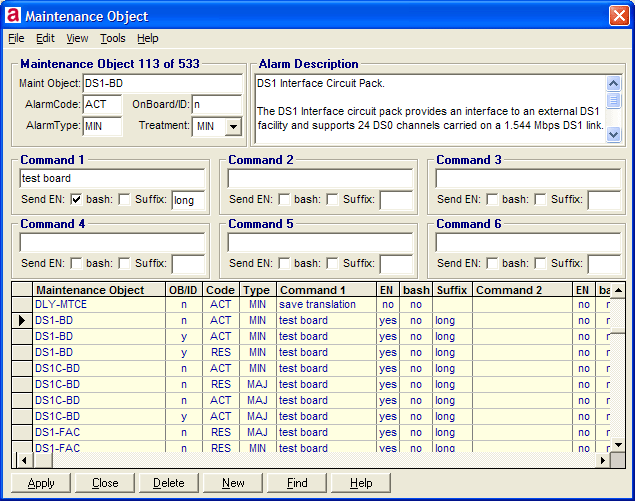Understanding Alarms and Warnings
When the phone system detects an error or alarm, the system will dial the telephone number (OSS) associated with AlarmTraq to send an alarm string. Once the alarm string is received by AlarmTraq, it is processed according to it’s severity and site profile settings.
First lets take a look at a typical alarm from a Definity G3:
| 123456789026/07:41,EOF,ACT|01A10,DS1-BD,y,MIN |
The alarm string contains all the information to identify the site (Product ID), Time, Date, MO, Equipment Number and severity of the alarm.
|
123456789026/07:41,EOF,ACT|01A10,DS1-BD,y,MIN |
This alarm is broken down as:
|
Definition |
Value |
Possible Values |
|
Product
ID |
1234567890 |
10
Digits |
|
Day |
26 |
1-31
(Day of the month) |
|
Time |
07:41 |
00:00
– 23:59 (Time) |
|
Emergency Xfer Status |
EOF |
EOF or
EOT |
| Alarm Code | ACT | ACT (Active), RES (Resource), TST (Test), RST (Reset) or CLR (Clear) |
|
Equipment Number |
01A10 |
TEXT
(UUCSS format) |
|
Maintenance Object |
DS1-BD |
TEXT |
|
OnBoard Alarm |
Y |
y/n or integer
|
|
Alarm Type |
MIN |
MAJ,
MIN or WAR
|
AlarmTraq will attempt to process the alarm in its internal database and then send notification of the alarm based on the severity (Alarm Type) via pager, email, cell phone, Blackberry, Printer and web.
Alarms that are reported to AlarmTraq
Alarms are classified as major, minor, or warning, depending the degree of severity and the effect on the system.
|
Alarm
Level and description |
Reported to AlarmTraq |
Reported to Attendant |
Action
to be taken |
|
Major
Critical Service degradation |
Y |
Y
After
4 attempts to contact AlarmTraq |
Immediate Action |
|
Minor
Could
be service effecting, usually only effects lines and trunks. |
Y |
Y
After
4 attempts to contact AlarmTraq |
Investigate problem and dispatch as needed |
|
Warning |
N
AlarmTraq will receive some messages if instructed |
N |
If
recurring problem investigate and dispatch as needed |
Understanding the Maintenance Object Database
When AlarmTraq receives an alarm from a system it looks in the alarm for what is called the Maintenance Object (MO). MOs are the software modules that monitor, test, and report possible fault conditions.
Once an alarm has been received by AlarmTraq and entered into the system, The specific MO is compared against the Maintenance Object Database to see if a match is found. If no match is found, the MO is automatically added to the database for future use.

Maintenance Object Database
If a match is found, the associated command(s) are formatted to so they can be interpreted by the switch. Using the alarm string from the previous chapter:
123456789026/07:41,EOF,ACT|01A10,DS1-BD,y,MIN;
The MO =
DS1-BD
The EN =
01A10
Maintenance
Object Database lookup:
Maint Object
= DS1-BD
AlarmCode =
ACT
AlarmType =
MIN
OnBoard =
Y
Command 1 =
test board
Send EN =
checked
Bash =
unchecked
Suffix =
long
Since a
match was found, the first command to be issued to the switch will be : ‘test
board 01A10 long’.
Sending commands using Auto Dial-Back
Multiple commands may be sent to the switch for any Maintenance Object Database entry.
Maintenance
Object
- Enter the
alarm maintenance object
Alarm Code
- Enter a valid alarm code. Valid configurations are:
-
ACT
-
RES
-
RST
-
CLR
Alarm Type -
Enter a valid alarm type. Valid configurations are:
-
MAJ - Major Alarm
-
MIN - Minor Alarm
-
WAR - Warning Message
OnBoard -
Enter y, n or a number (0-10)
Dial-Back Command
Command
(1 – 6)
- Enter a
valid command to test this Maintenance object
Send EN
- Select this checkbox if you want to send the port information with the
command. Examples are:
·
Select
the Send EN checkbox for the following type of commands:
-
test board 01a04 short
-
test fiber-link 01 long
-
test port 01a0702 short
·
Do Not
select
the Send EN checkbox for the following commands:
-
test synchronization
-
test alarms clear short
-
test inads-link
bash -
Select this checkbox if you want to send the command from the ‘bash prompt’ on
an S8xx0 system.
Suffix
- Enter a valid command suffix Examples are:
-
test board 01a04 short
-
test fiber-link 01 long
-
test port 01a0702 short
-
test alarms clear short
Considerations when using Auto Dial-Back
In order for AlarmTraq to successfully issue commands to your switch, the site profile must contain:
-
A valid telephone number
to dial.
-
A valid login username
with maintenance permissions (MSP) such as ‘dadmin’, ‘inads’, or ‘craft’.
-
A valid password for the
login user name.
-
The “Run Command(s)
After Receiving Alarm” checkbox must be selected.
- The “Outgoing Group” for this site must be a valid outgoing capable group.
